Radiotherapy for Clinically Localized T3b or T4 Very-High-Risk Prostate Cancer-Role of Dose Escalation Using High-Dose-Rate Brachytherapy Boost or High Dose Intensity Modulated Radiotherapy
Abstract
Simple Summary
Abstract
1. Introduction
2. Materials and Methods
2.1. Patients
2.2. Treatment Planning
2.2.1. High Dose Rate Brachytherapy Boost with External Beam Radiotherapy (HDR Boost)
2.2.2. External Beam Radiotherapy (EBRT: Conv. and High Dose Group)
2.3. Statistical Analysis
3. Results
3.1. Patient and Tumor Characteristics
3.2. Biochemical Control (bDFS), Prostate Cancer-Specific (PSS), and Overall (OS)
3.3. Toxicity
3.3.1. Acute Toxicity
3.3.2. Late Toxicity
4. Discussion
5. Conclusions
Supplementary Materials
Author Contributions
Funding
Institutional Review Board Statement
Informed Consent Statement
Data Availability Statement
Acknowledgments
Conflicts of Interest
References
- American Cancer Society. Cancer Facts & Figures 2019. Survival Rates for Prostate Cancer. Available online: https://www.cancer.org/cancer/prostate-cancer/detection-diagnosis-staging/survival-rates.html (accessed on 30 January 2021).
- The National Comprehensive Cancer Network Clinical Practice Guidelines in Oncology. Prostate Cancer-Version 4. 2019. Available online: http://www.nccn.org/professionals/physician_gls/pdf/prostate.pdf (accessed on 2 February 2020).
- Rades, D.; Schwarz, R.; Todorovic, M.; Thurmann, H.; Graefen, M.; Walz, J.; Schild, S.E.; Dunst, J.; Alberti, W. Experiences with a new high-dose-rate brachytherapy (HDR-BT) boost technique for T3b prostate cancer. Strahlenther. Onkol. 2007, 183, 398–402. [Google Scholar] [CrossRef]
- Ishiyama, H.; Satoh, T.; Kitano, M.; Tabata, K.-I.; Komori, S.; Ikeda, M.; Soda, I.; Kurosaka, S.; Sekiguchi, A.; Kimura, M.; et al. High-dose-rate brachytherapy and hypofractionated external beam radiotherapy combined with long-term hormonal therapy for high-risk and very high-risk prostate cancer: Outcomes after 5-year follow-up. J. Radiat. Res. 2014, 55, 509–517. [Google Scholar] [CrossRef] [PubMed]
- Kasahara, T.; Ishizaki, F.; Kazama, A.; Yuki, E.; Yamana, K.; Maruyama, R.; Oshikane, T.; Kaidu, M.; Aoyama, H.; Bilim, V.; et al. High-dose-rate brachytherapy and hypofractionated external beam radiotherapy combined with long-term androgen deprivation therapy for very high-risk prostate cancer. Int. J. Urol. 2020, 27, 800–806. [Google Scholar] [CrossRef]
- Viani, G.A.; Stefano, E.J.; Afonso, S.L. Higher-Than-Conventional Radiation Doses in Localized Prostate Cancer Treatment: A Meta-analysis of Randomized, Controlled Trials. Int. J. Radiat. Oncol. 2009, 74, 1405–1418. [Google Scholar] [CrossRef]
- Zaorsky, N.G.; Doyle, L.A.; Yamoah, K.; Andrel, J.A.; Trabulsi, E.J.; Hurwitz, M.D.; Dicker, A.P.; Den, R.B. High dose rate brachytherapy boost for prostate cancer: A systematic review. Cancer Treat. Rev. 2014, 40, 414–425. [Google Scholar] [CrossRef]
- Yoshioka, Y.; Yoshida, K.; Yamazaki, H.; Nonomura, N.; Ogawa, K. The emerging role of high-dose-rate (HDR) brachytherapy as monotherapy for prostate cancer. J. Radiat. Res. 2013, 54, 781–788. [Google Scholar] [CrossRef]
- Yamazaki, H.; Masui, K.; Suzuki, G.; Nakamura, S.; Yamada, K.; Okihara, K.; Shiraishi, T.; Yoshida, K.; Kotsuma, T.; Tanaka, E.; et al. High-dose-rate brachytherapy monotherapy versus low-dose-rate brachytherapy with or without external beam radiotherapy for clinically localized prostate cancer. Radiother. Oncol. 2019, 132, 162–170. [Google Scholar] [CrossRef] [PubMed]
- Ishiyama, H.; Kamitani, N.; Kawamura, H.; Kato, S.; Aoki, M.; Kariya, S.; Matsumura, T.; Kaidu, M.; Yoshida, K.; Hashimoto, Y.; et al. Nationwide multi-institutional retrospective analysis of high-dose-rate brachytherapy combined with external beam radiotherapy for localized prostate cancer: An Asian Prostate HDR-BT Consortium. Brachytherapy 2017, 16, 503–510. [Google Scholar] [CrossRef]
- An Open Data of Multicenter Data Collection: Outcome of Radiation Therapy for Prostate Cancer to Establish a Prognostic Prediction System by Machine Learning (B17-278). Available online: https://www.khp.kitasato-u.ac.jp/ska/radiotherapy/arcivements/#results (accessed on 2 February 2020).
- Sasaki, N.; Yamazaki, H.; Shimizu, D.; Suzuki, G.; Masui, K.; Nakamura, S.; Okabe, H.; Nishikawa, T.; Yoshida, K. Long-term Outcomes of a Dose–reduction Trial to Decrease Late Gastrointestinal Toxicity in Patients with Prostate Cancer Receiving Soft Tissue-matched Image-guided Intensity-modulated Radiotherapy. Anticancer. Res. 2018, 38, 385–391. [Google Scholar] [CrossRef]
- Narang, A.K.; Gergis, C.; Robertson, S.P.; He, P.; Ram, A.N.; McNutt, T.R.; Griffith, E.; Deweese, T.A.; Honig, S.; Singh, H.; et al. Very High-Risk Localized Prostate Cancer: Outcomes Following Definitive Radiation. Int. J. Radiat. Oncol. 2016, 94, 254–262. [Google Scholar] [CrossRef]
- Goupy, F.; Supiot, S.; Pasquier, D.; Latorzeff, I.; Schick, U.; Monpetit, E.; Martinage, G.; Hervé, C.; Le Proust, B.; Castelli, J.; et al. Intensity-modulated radiotherapy for prostate cancer with seminal vesicle involvement (T3b): A multicentric retrospective analysis. PLoS ONE 2019, 14, e0210514. [Google Scholar] [CrossRef]
- Deutsch, I.; Zelefsky, M.J.; Zhang, Z.; Mo, Q.; Zaider, M.; Cohen, G.; Cahlon, O.; Yamada, Y. Comparison of PSA relapse-free survival in patients treated with ultra-high-dose IMRT versus combination HDR brachytherapy and IMRT. Brachytherapy 2010, 9, 313–318. [Google Scholar] [CrossRef]
- Stock, R.G.; Buckstein, M.; Liu, J.T.; Stone, N.N. The relative importance of hormonal therapy and biological effective dose in optimizing prostate brachytherapy treatment outcomes. BJU Int. 2013, 112, E44–E50. [Google Scholar] [CrossRef]
- Eade, T.N.; Hanlon, A.L.; Horwitz, E.M.; Buyyounouski, M.K.; Hanks, G.E.; Pollack, A. What Dose of External-Beam Radiation is High Enough for Prostate Cancer? Int. J. Radiat. Oncol. 2007, 68, 682–689. [Google Scholar] [CrossRef] [PubMed]
- Pollack, A.; Zagars, G.K.; Starkschall, G.; Antolak, J.A.; Lee, J.; Huang, E.; Von Eschenbach, A.C.; A Kuban, D.; Rosen, I. Prostate cancer radiation dose response: Results of the M. D. Anderson phase III randomized trial. Int. J. Radiat. Oncol. 2002, 53, 1097–1105. [Google Scholar] [CrossRef]
- Zelefsky, M.J.; Chan, H.; Hunt, M.; Yamada, Y.; Shippy, A.M.; Amols, H. Long-Term Outcome of High Dose Intensity Modulated Radiation Therapy for Patients with Clinically Localized Prostate Cancer. J. Urol. 2006, 176, 1415–1419. [Google Scholar] [CrossRef]
- Zapatero, A.; Guerrero, A.; Maldonado, X.; Alvarez, A.; Gonzalez San Segundo, C.; Cabeza Rodríguez, M.A.; Macias, V.; Pedro Olive, A.; Casas, F.; Boladeras, A.; et al. High-dose radiotherapy with short-term or long-term androgen deprivation in localised prostate cancer (DART01/05 GICOR): A randomised, controlled, phase 3 trial. Lancet Oncol. 2015, 16, 320–327. [Google Scholar] [CrossRef]
- Yamazaki, H.; Nakamura, S.; Nishimura, T.; Yoshida, K.; Yoshioka, Y.; Koizumi, M.; Ogawa, K. Transitioning from conventional radiotherapy to intensity-modulated radiotherapy for localized prostate cancer: Changing focus from rectal bleeding to detailed quality of life analysis. J. Radiat. Res. 2014, 55, 1033–1047. [Google Scholar] [CrossRef]
- Fukagai, T.; Namiki, T.S.; Carlile, R.G.; Yoshida, H.; Namiki, M. Comparison of the clinical outcome after hormonal therapy for prostate cancer between Japanese and Caucasian men. BJU Int. 2006, 97, 1190–1193. [Google Scholar] [CrossRef]
- Chin, J.; Rumble, R.B.; Kollmeier, M.; Heath, E.; Efstathiou, J.; Dorff, T.; Berman, B.; Feifer, A.; Jacques, A.; Loblaw, D.A. Brachytherapy for Patients with Prostate Cancer: American Society of Clinical Oncology/Cancer Care Ontario Joint Guideline Update. J. Clin. Oncol. 2017, 35, 1737–1743. [Google Scholar] [CrossRef] [PubMed]
- Dess, R.T.; Soni, P.D.; Jackson, W.C.; Berlin, A.; Cox, B.W.; Jolly, S.; Efstathiou, J.A.; Feng, F.Y.; Kishan, A.U.; Stish, B.J.; et al. The current state of randomized clinical trial evidence for prostate brachytherapy. Urol. Oncol. Semin. Orig. Investig. 2019, 37, 599–610. [Google Scholar] [CrossRef]
- Yamazaki, H.; Masui, K.; Suzuki, G.; Nakamura, S.; Yoshida, K.; Kotsuma, T.; Tanaka, E.; Otani, K.; Yoshioka, Y.; Ogawa, K. Comparison of three moderate fractionated schedules employed in high-dose-rate brachytherapy monotherapy for clinically localized prostate cancer. Radiother. Oncol. 2018, 129, 370–376. [Google Scholar] [CrossRef] [PubMed]
- Spratt, D.E.; Zumsteg, Z.S.; Ghadjar, P.; Kollmeier, M.A.; Pei, X.; Cohen, G.; Polkinghorn, W.; Yamada, Y.; Zelefsky, M.J. Comparison of high-dose (86.4 Gy) IMRT vs combined brachytherapy plus IMRT for intermediate-risk prostate cancer. BJU Int. 2014, 114, 360–367. [Google Scholar] [CrossRef] [PubMed]
- Kent, A.R.; Matheson, B.; Millar, J.L. Improved survival for patients with prostate cancer receiving high-dose-rate brachytherapy boost to EBRT compared with EBRT alone. Brachytherapy 2019, 18, 313–321. [Google Scholar] [CrossRef]
- Wedde, T.B.; Smastuen, M.C.; Brabrand, S.; Fossa, S.D.; Kaasa, S.; Tafjord, G.; Russnes, K.M.; Hellebust, T.P.; Lilleby, W. Ten-year survival after high-dose-rate brachytherapy combined with external beam radiation therapy in high-risk prostate cancer: A comparison with the Norwegian SPCG-7 cohort. Radiother. Oncol. 2019, 132, 211–217. [Google Scholar] [CrossRef] [PubMed]
- Nguyen, Q.-N.; Levy, L.B.; Lee, A.K.; Choi, S.S.; Frank, S.J.; Pugh, T.J.; McGuire, S.; Hoffman, K.; Kuban, D.A. Long-term outcomes for men with high-risk prostate cancer treated definitively with external beam radiotherapy with or without androgen deprivation. Cancer 2013, 119, 3265–3271. [Google Scholar] [CrossRef]
- Survival Statistics of Japanese Association of Clinical Cancer Centers Cancer Survival Rates at Japanese Association of Clinical Cancer Centers. Available online: https://ganjoho.jp/data/reg_stat/statistics/brochure/2016/cancer_statistics_2016_app_E.pdf (accessed on 2 December 2020).
- Carvalho, Í.T.; Baccaglini, W.; Claros, O.R.; Chen, F.K.; Kayano, P.P.; Lemos, G.C.; Weltman, E.; Kuban, D.A.; Carneiro, A. Genitourinary and gastrointestinal toxicity among patients with localized prostate cancer treated with conventional versus moderately hypofractionated radiation therapy: Systematic review and meta-analysis. Acta Oncol. 2018, 57, 1003–1010. [Google Scholar] [CrossRef] [PubMed]
- Takemoto, S.; Shibamoto, Y.; Sugie, C.; Manabe, Y.; Yanagi, T.; Iwata, H.; Murai, T.; Ishikura, S. Long-term results of intensity-modulated radiotherapy with three dose-fractionation regimens for localized prostate cancer. J. Radiat. Res. 2018, 60, 221–227. [Google Scholar] [CrossRef] [PubMed]
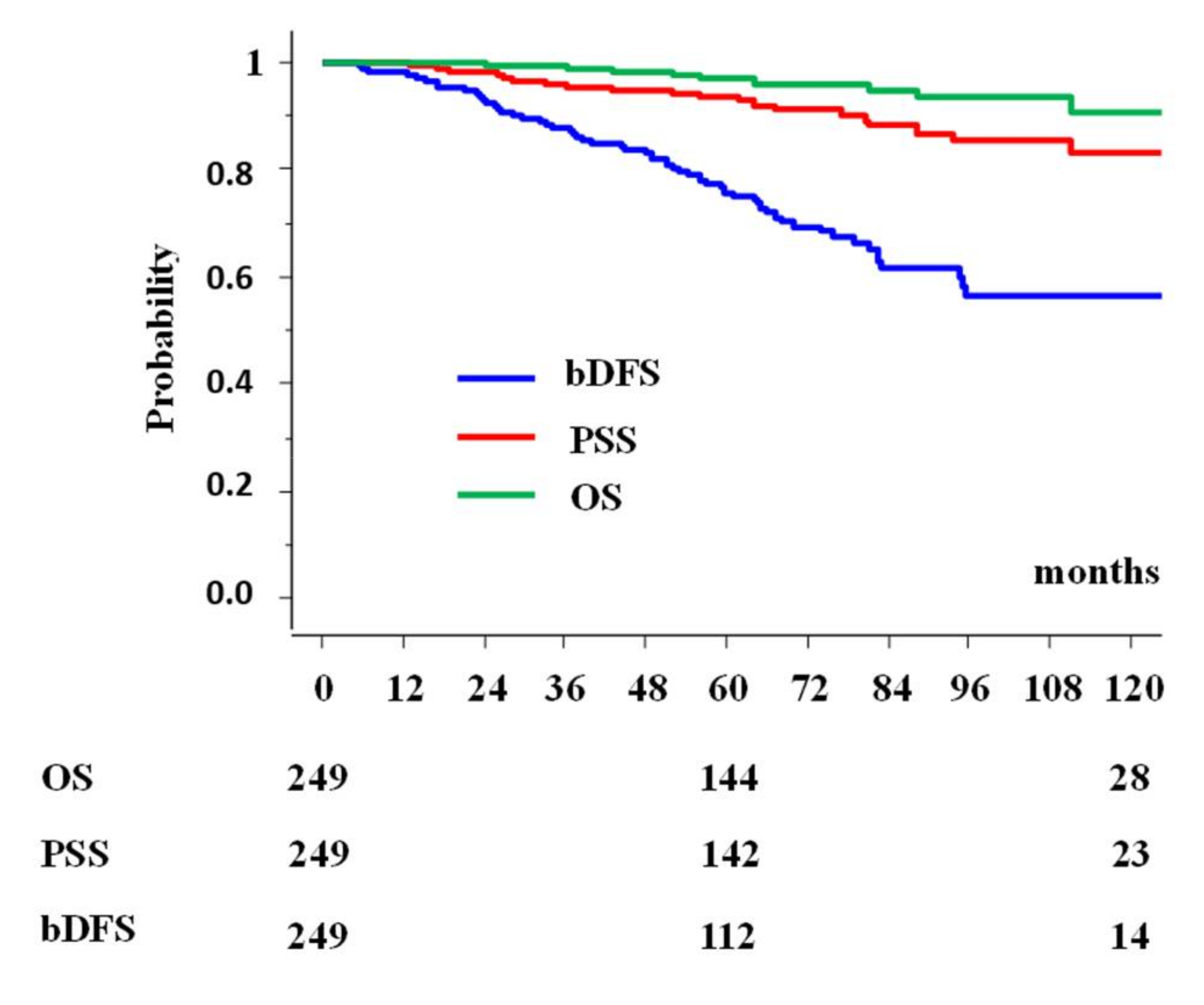
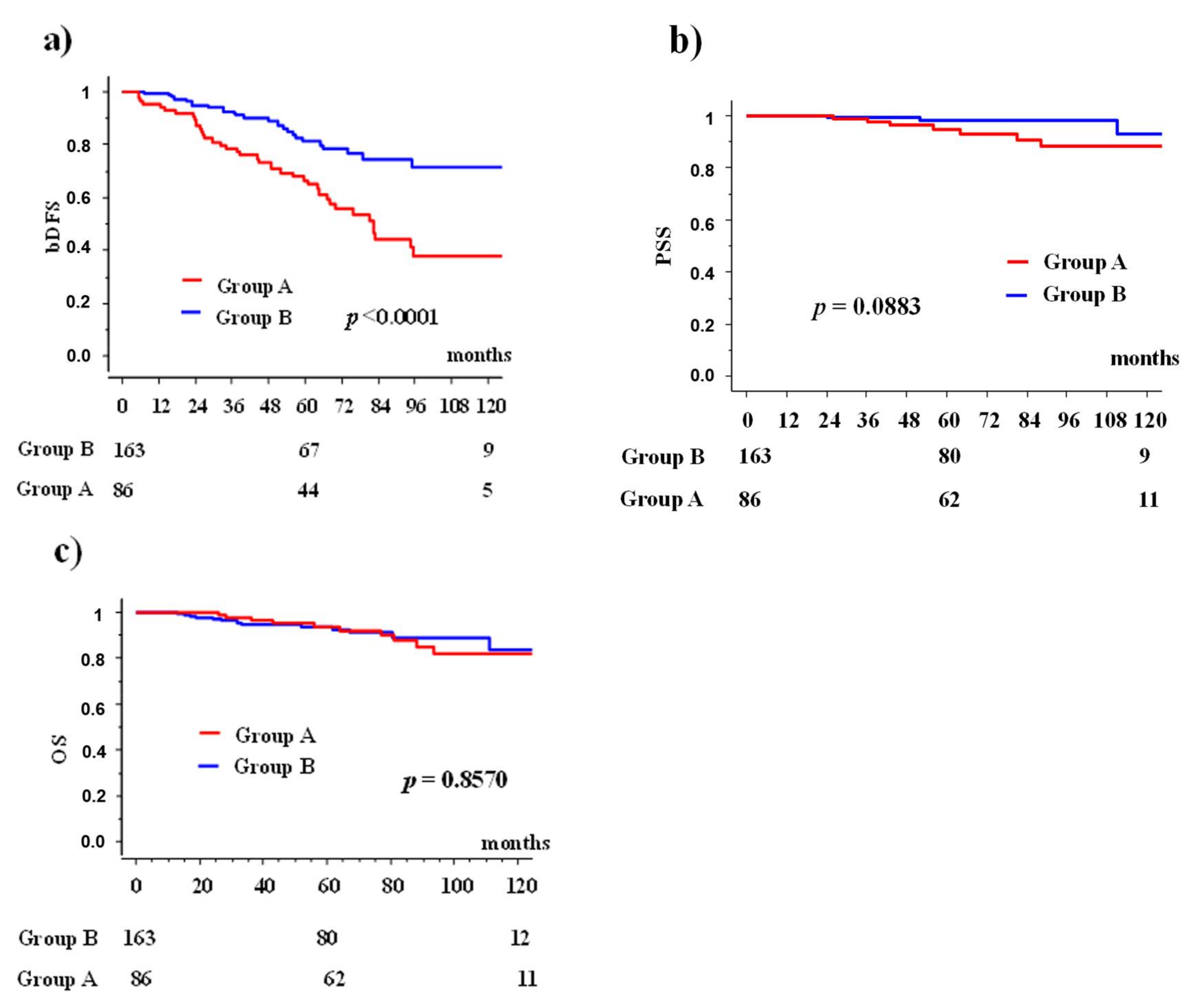
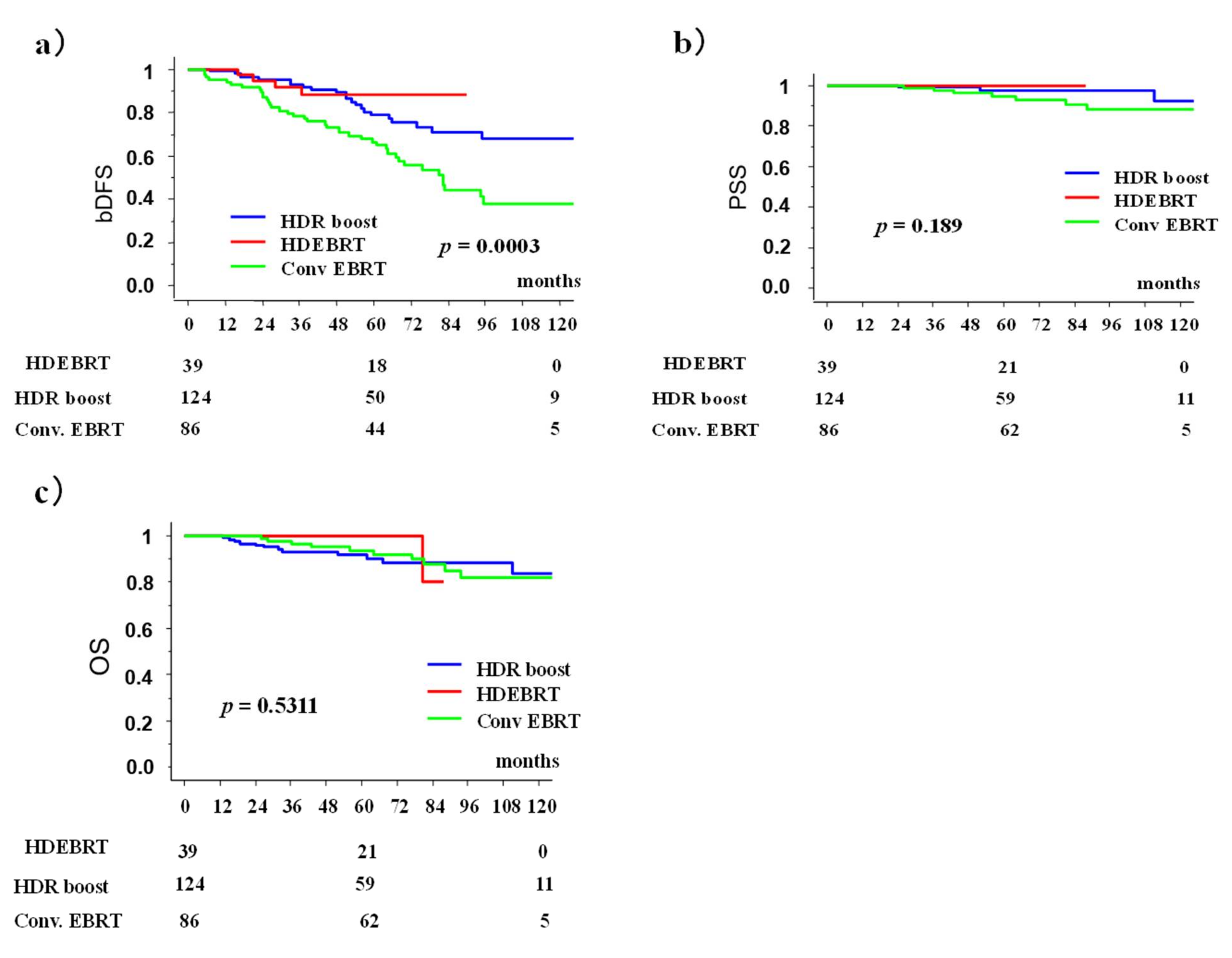
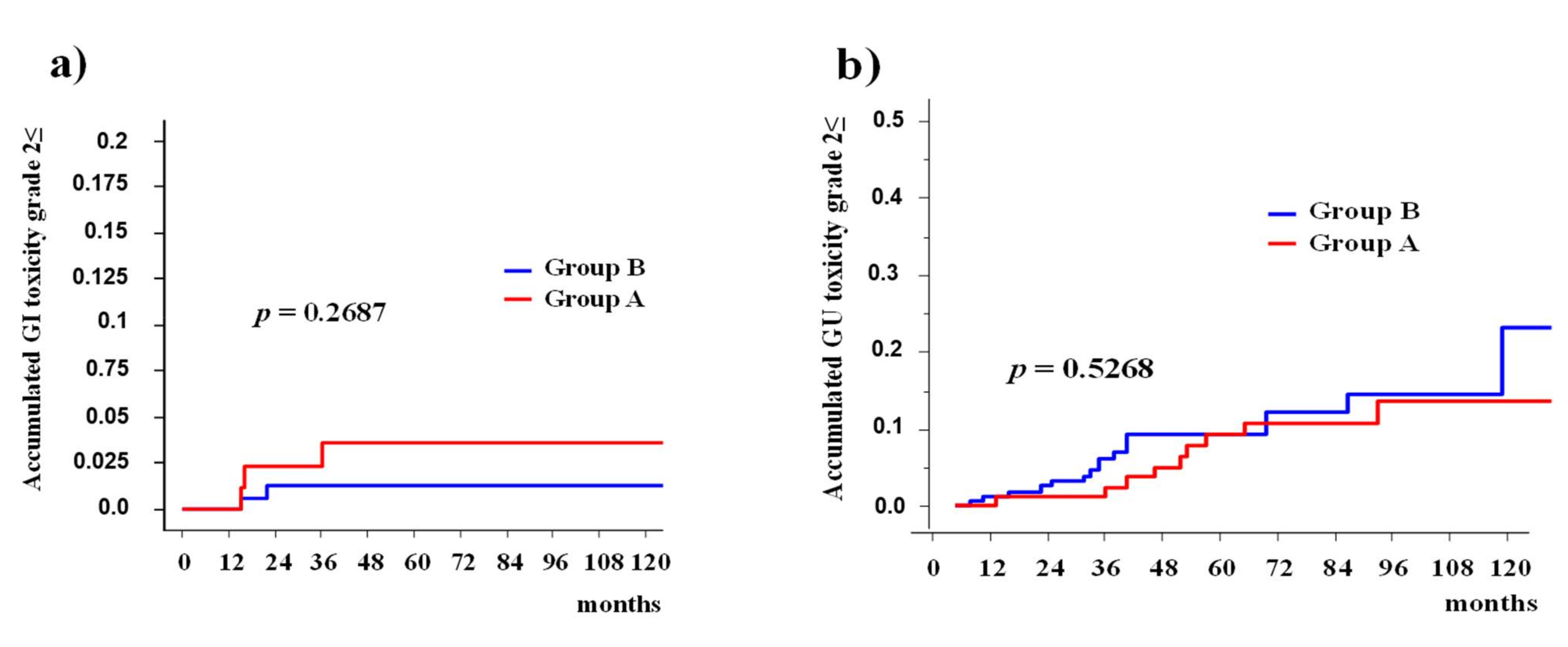
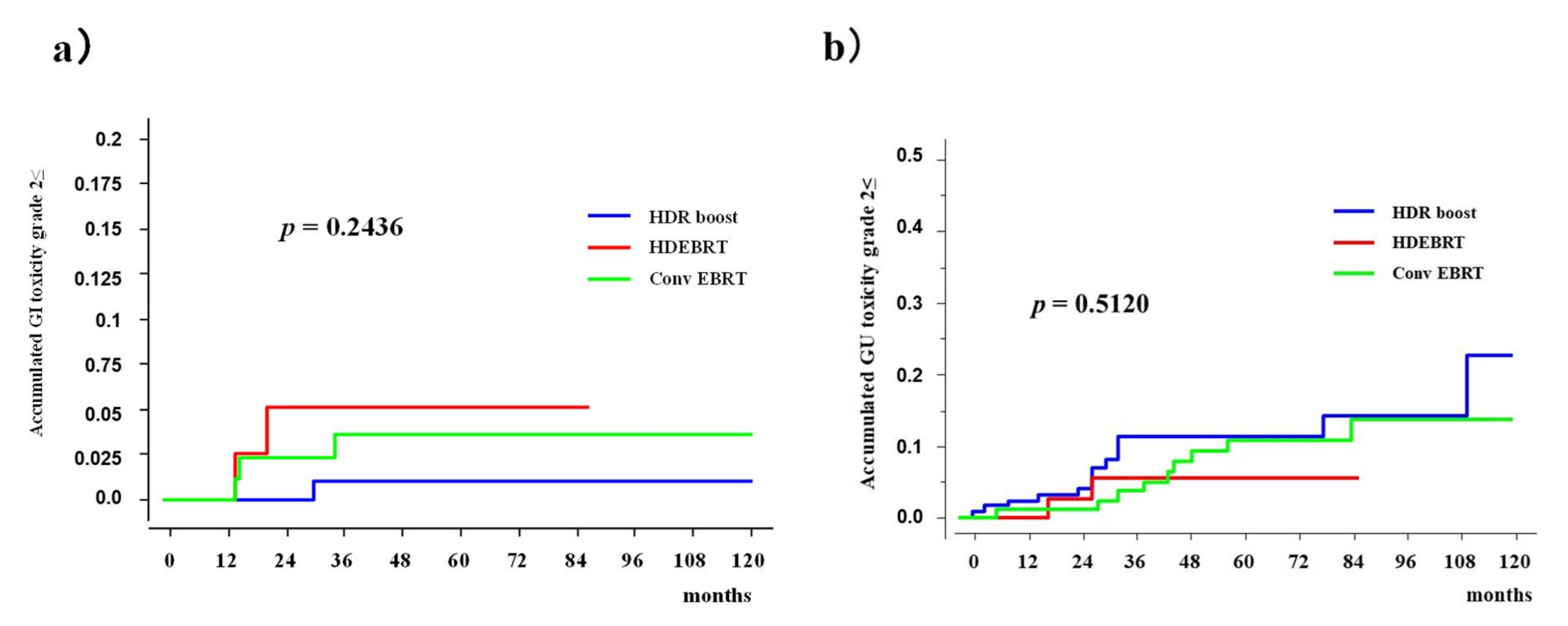
| Variables | Strata | Group A | Group B | p-Value | ||
|---|---|---|---|---|---|---|
| Conv. EBRT | High Dose EBRT + HDR Boost (n = 163) | |||||
| (n = 86) | ||||||
| No. Or | (%) | No. Or | (%) | |||
| Median (Range) | Median (Range) | |||||
| Age | 70.5 (60–89) | 72 (60–86) | 0.3999 | |||
| T category | 3b | 67 | −78% | 149 | −91% | |
| 4 | 19 | −22% | 14 | −9% | 0.0028 | |
| iPSA | (ng/mL) | 42.07 (3.4–398) | 31.5 (4.7–486) | 0.5272 | ||
| Gleason score | −6 | 0 | 0% | 13 | −8% | |
| 7 | 34 | −40% | 64 | −39% | ||
| 8 | 51 | −59% | 86 | −53% | 0.0258 | |
| Prescribed dose | (Gy) | 72 (70–72) | 108.7 (74–129) | <0.0001 | ||
| (EQD 2 Gy) | ||||||
| Hormonal therapy | Yes | 86 | −100% | 159 | −98% | 0.349 |
| Neoadjuvant | months | 7.5 (2–18) | 11 (11–74) | <0.0001 | ||
| Adjuvant | months | 20 (1–30) | 36 (3–114) | <0.0001 | ||
| No | 0 | 0% | 4 | −2% | ||
| Follow-up | (Months) | 77.5 (18.7–135) | 57 (13–153) | <0.0001 | ||
| Group A | Group B | |||||||
|---|---|---|---|---|---|---|---|---|
| Conv. EBRT (n = 86) | High Dose EBRT (n = 39) | HDR Boost (n = 124) | ||||||
| Prescribed Dose | No. | (%) | Prescribed Dose | No. | (%) | Prescribed Dose | No. | (%) |
| 70 Gy/35 fr 1 | 14 | −16% | 74 Gy/36 fr | 12 | −31% | 18 Gy/2 fr +EBRT 39 Gy/13 fr (n = 10) or | 25 | −20% |
| 51 Gy/17 fr (n = 14) or | ||||||||
| 48 Gy/16 fr (n = 1) | ||||||||
| 72 Gy/36 fr 2 | 72 | −84% | 78 Gy/39 fr 3 | 14 | −36% | 20 Gy/2 fr + EBRT46 Gy/23 fr 4 | 4 | −3% |
| 74.8 Gy/34 fr | 8 | −21% | 21 Gy/2 fr + EBRT 45 Gy/15 fr (n = 4) | 5 | −4% | |||
| 21 Gy/3 fr + EBRT 51 Gy/17 fr (n = 1) | ||||||||
| 80 Gy/40 fr | 4 | −10% | 31.5 Gy/5 fr + EBRT 30 Gy/10 fr | 90 | −73% | |||
| 70 Gy/28 fr | 1 | −3% | ||||||
| Variables | Strata | Univariate Analysis | Multivariate Analysis | ||||
|---|---|---|---|---|---|---|---|
| HR | 95% CI | p-Value | HR | 95% CI | p-Value | ||
| Age, years | ≤70 | 1 | (referent) | - | 1 | (referent) | - |
| 71≤ | 1.498 | 0.925–2.425 | 0.1004 | 1.67 | 1.007–2.769 | 0.0468 | |
| Gleason score | ≤7 | 1 | (referent) | - | 1 | (referent) | - |
| 8≤ | 2.148 | 1.270–3.634 | 0.0043 | 2.004 | 1.182–3.399 | 0.0099 | |
| Pretreatment PSA (ng/mL) | ≤20 | 1 | (referent) | - | 1 | (referent) | - |
| 20< | 1.424 | 0.863–2.351 | 0.167 | 1.984 | 1.097–3.215 | 0.0215 | |
| Modality | Group A | 1 | (referent) | - | 1 | (referent) | - |
| Group B | 0.258 | 0.092–0.723 | 0.0011 | 0.397 | 0.241–0.654 | 0.0003 | |
| Toxicities | Grade | Group A. (n = 86) | Group B (n = 163) | p-Value | ||
|---|---|---|---|---|---|---|
| No. | (%) | No. | (%) | |||
| Genitourinary | 0 | 33 | −38% | 62 | −38% | 0.0566 |
| 1 | 48 | −56% | 75 | −46% | ||
| 2 | 5 | −6% | 26 | −16% | ||
| 3 | 0 | 0% | 0 | 0% | ||
| Gastrointestinal | 0 | 45 | −52% | 150 | −92% | <0.0001 |
| 1 | 40 | −47% | 13 | −8% | ||
| 2 | 1 | −1% | 0 | 0% | ||
| 3 | 0 | 0% | 0 | 0% | ||
| Toxicities | Grade | Group A. (n = 86) | Group B (n = 163) | p-Value | ||
|---|---|---|---|---|---|---|
| No. | (%) | No. | (%) | |||
| Genitourinary | 0 | 69 | (80%) | 92 | (56%) | 0.0004 |
| 1 | 8 | (9%) | 55 | (34%) | ||
| 2 | 5 | (6%) | 9 | (6%) | ||
| 3 | 4 | (5%) | 7 | (4%) | ||
| Gastrointestinal | 0 | 65 | (76%) | 145 | (89%) | 0.0382 |
| 1 | 18 | (21%) | 14 | (9%) | ||
| 2 | 1 | (1%) | 3 | (2%) | ||
| 3 | 1 | (1%) | 1 | (1%) | ||
Publisher’s Note: MDPI stays neutral with regard to jurisdictional claims in published maps and institutional affiliations. |
© 2021 by the authors. Licensee MDPI, Basel, Switzerland. This article is an open access article distributed under the terms and conditions of the Creative Commons Attribution (CC BY) license (https://creativecommons.org/licenses/by/4.0/).
Share and Cite
Yamazaki, H.; Suzuki, G.; Masui, K.; Aibe, N.; Shimizu, D.; Kimoto, T.; Yoshida, K.; Nakamura, S.; Okabe, H. Radiotherapy for Clinically Localized T3b or T4 Very-High-Risk Prostate Cancer-Role of Dose Escalation Using High-Dose-Rate Brachytherapy Boost or High Dose Intensity Modulated Radiotherapy. Cancers 2021, 13, 1856. https://doi.org/10.3390/cancers13081856
Yamazaki H, Suzuki G, Masui K, Aibe N, Shimizu D, Kimoto T, Yoshida K, Nakamura S, Okabe H. Radiotherapy for Clinically Localized T3b or T4 Very-High-Risk Prostate Cancer-Role of Dose Escalation Using High-Dose-Rate Brachytherapy Boost or High Dose Intensity Modulated Radiotherapy. Cancers. 2021; 13(8):1856. https://doi.org/10.3390/cancers13081856
Chicago/Turabian StyleYamazaki, Hideya, Gen Suzuki, Koji Masui, Norihiro Aibe, Daisuke Shimizu, Takuya Kimoto, Ken Yoshida, Satoaki Nakamura, and Haruumi Okabe. 2021. "Radiotherapy for Clinically Localized T3b or T4 Very-High-Risk Prostate Cancer-Role of Dose Escalation Using High-Dose-Rate Brachytherapy Boost or High Dose Intensity Modulated Radiotherapy" Cancers 13, no. 8: 1856. https://doi.org/10.3390/cancers13081856
APA StyleYamazaki, H., Suzuki, G., Masui, K., Aibe, N., Shimizu, D., Kimoto, T., Yoshida, K., Nakamura, S., & Okabe, H. (2021). Radiotherapy for Clinically Localized T3b or T4 Very-High-Risk Prostate Cancer-Role of Dose Escalation Using High-Dose-Rate Brachytherapy Boost or High Dose Intensity Modulated Radiotherapy. Cancers, 13(8), 1856. https://doi.org/10.3390/cancers13081856








